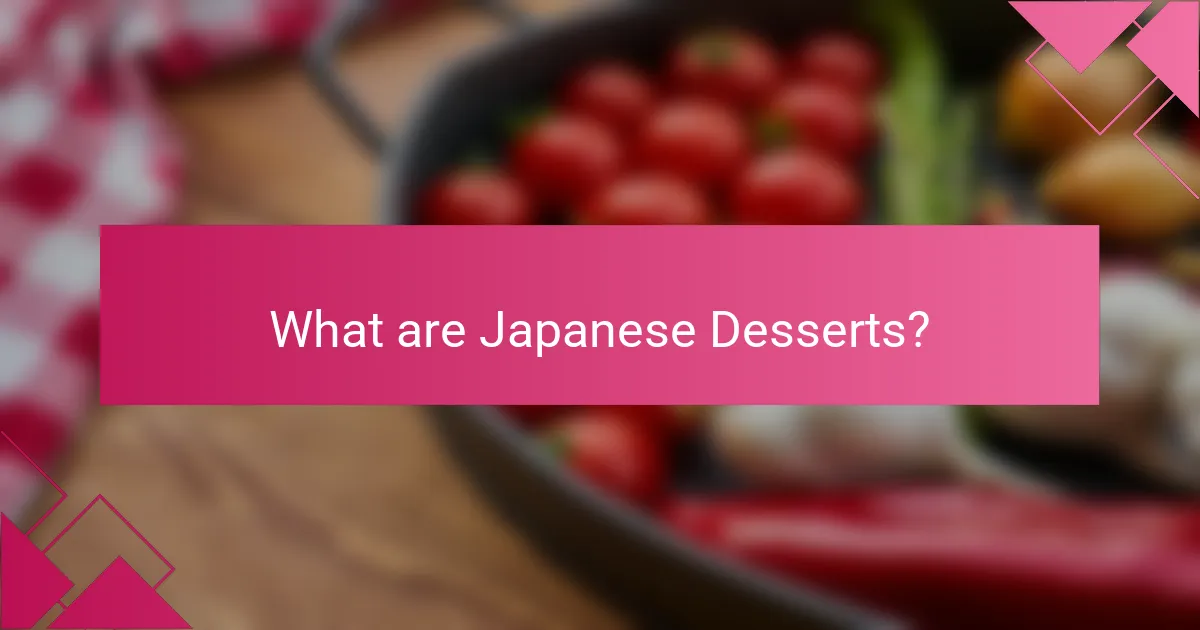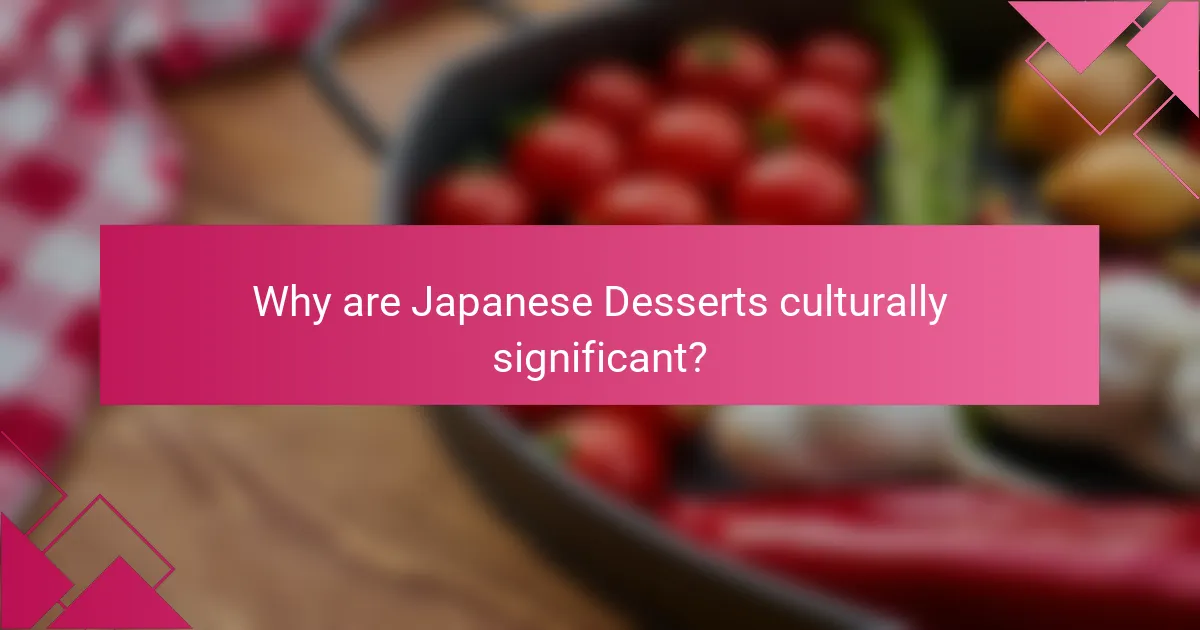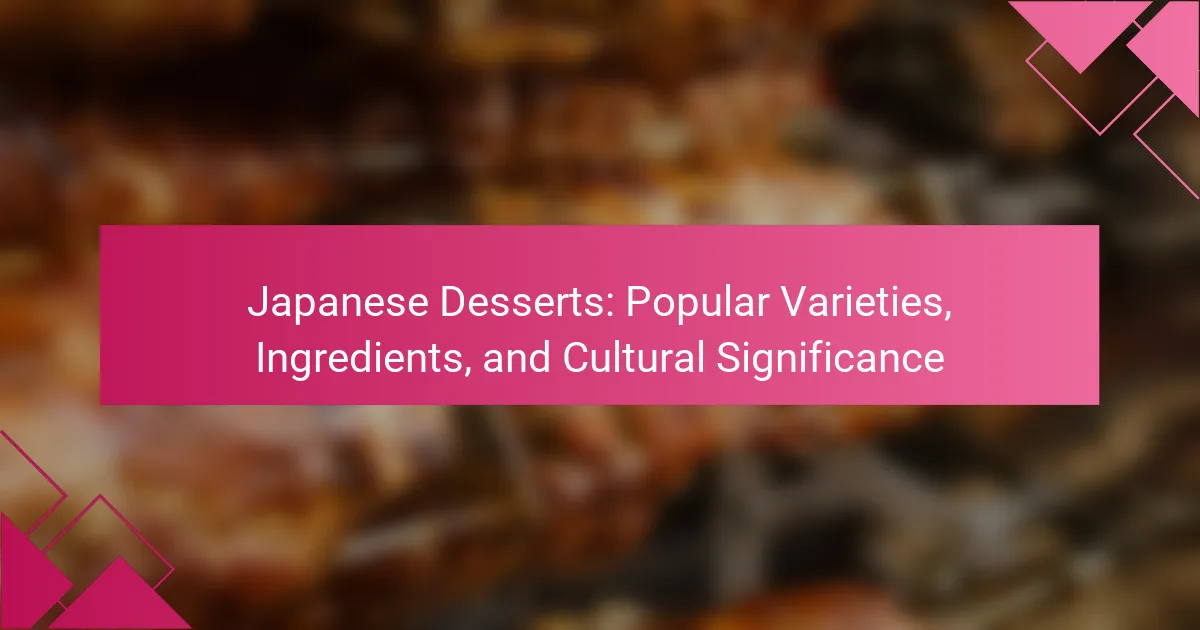
What are Japanese Desserts?
Japanese desserts are sweet dishes that originate from Japan. They often feature unique ingredients like rice, beans, and matcha. Traditional Japanese desserts include mochi, dorayaki, and anmitsu. Mochi is a sticky rice cake that can be filled with sweet red bean paste. Dorayaki consists of two fluffy pancakes filled with sweetened red bean paste. Anmitsu is a jelly dessert served with fruits and syrup. These desserts emphasize balance and presentation. They often reflect seasonal ingredients and cultural practices. Japanese desserts are enjoyed during festivals and special occasions, showcasing the country’s culinary artistry.
How do Japanese Desserts differ from other dessert traditions?
Japanese desserts differ from other dessert traditions primarily in their use of ingredients and presentation. Traditional Japanese sweets often feature rice, beans, and matcha, contrasting with Western desserts that frequently use flour and sugar. Japanese desserts emphasize subtle flavors and textures, focusing on harmony and balance. For instance, mochi is a glutinous rice cake that showcases a chewy texture, which is less common in other dessert cultures. Additionally, many Japanese desserts are low in sweetness, appealing to a different palate. Seasonal ingredients play a significant role in Japanese desserts, reflecting the changing seasons, unlike many Western desserts that may prioritize consistency year-round. The aesthetic presentation of Japanese sweets is also crucial, often designed to evoke nature and seasonal beauty, which is less emphasized in other traditions.
What cultural influences shape Japanese Desserts?
Japanese desserts are shaped by various cultural influences, including traditional Japanese aesthetics, seasonal ingredients, and historical interactions with foreign cultures. The concept of “wabi-sabi” emphasizes simplicity and imperfection, which is reflected in the presentation of desserts. Seasonal ingredients play a crucial role, as many sweets are designed to celebrate specific seasons, such as sakura (cherry blossoms) in spring. Historical influences include the introduction of Western desserts during the Meiji era, leading to fusion creations like cake and pastries. Additionally, Buddhist practices have influenced the use of natural ingredients and the avoidance of animal products in certain sweets. These cultural elements combine to create a unique dessert landscape in Japan, showcasing both tradition and innovation.
What are the historical origins of Japanese Desserts?
Japanese desserts, known as wagashi, have roots that trace back to ancient Japan. They originally evolved from Chinese sweets introduced during the Tang dynasty. The introduction of rice cultivation in Japan around 300 BC led to the creation of rice-based confections.
During the Heian period (794-1185), the art of wagashi flourished, often served during tea ceremonies. The use of seasonal ingredients became a hallmark of these desserts. By the Edo period (1603-1868), wagashi diversified significantly, incorporating various regional ingredients and techniques.
Influences from Western desserts began in the Meiji era (1868-1912), leading to new hybrid creations. Today, Japanese desserts reflect a blend of traditional and modern influences, showcasing the country’s rich culinary history.
What are the most popular varieties of Japanese Desserts?
The most popular varieties of Japanese desserts include mochi, dorayaki, and matcha-flavored treats. Mochi is a glutinous rice cake often filled with sweet red bean paste or ice cream. Dorayaki consists of two fluffy pancakes filled with sweet red bean paste. Matcha desserts, such as matcha ice cream and matcha cheesecake, are made using powdered green tea. Other notable varieties include taiyaki, a fish-shaped cake filled with sweet fillings, and anmitsu, a traditional jelly dessert served with fruits and syrup. These desserts are celebrated for their unique textures and flavors, reflecting Japan’s culinary traditions.
What are the characteristics of Mochi?
Mochi is a sticky rice cake made from glutinous rice. It has a chewy texture that is distinctive and enjoyable. Mochi is often shaped into small, round forms. It can be eaten plain or filled with various ingredients. Common fillings include red bean paste, ice cream, or fruit. Mochi is gluten-free, making it suitable for those with gluten sensitivities. It is traditionally used in Japanese celebrations and rituals. The preparation involves steaming and pounding rice until it becomes a smooth, elastic dough. Mochi’s versatility allows it to be used in both sweet and savory dishes.
How is Dorayaki made and served?
Dorayaki is made by preparing two fluffy, pancake-like cakes. These cakes are typically made from a batter of eggs, sugar, flour, and honey. The batter is cooked on a griddle until golden brown on both sides. After cooking, a sweet red bean paste, called anko, is placed between two cakes. This creates a sandwich-like dessert.
Dorayaki is often served at room temperature or slightly warm. It is commonly enjoyed as a snack or dessert. In Japan, dorayaki is popular among children and adults alike. It is frequently featured in various cultural events and gatherings.
What makes Taiyaki a unique dessert experience?
Taiyaki is a unique dessert experience due to its distinctive fish shape and filled center. This Japanese treat is made from a batter similar to pancake or waffle mix. The batter is cooked in a fish-shaped mold, creating a crispy exterior. The filling can vary, with popular options including red bean paste, custard, and chocolate. The combination of textures, with a crunchy outside and soft inside, enhances the eating experience. Taiyaki is often enjoyed hot, adding to its appeal. Its historical roots date back to the early 20th century in Japan. This dessert is not only visually appealing but also offers a variety of flavors, making it popular among diverse audiences.
What key ingredients are commonly used in Japanese Desserts?
Key ingredients commonly used in Japanese desserts include rice flour, adzuki beans, matcha, and mochi. Rice flour is essential for making traditional sweets like dango and mochi. Adzuki beans are often sweetened and used in fillings for desserts such as anmitsu and dorayaki. Matcha, a finely ground green tea powder, adds flavor and color to various confections, including matcha ice cream and cakes. Mochi, a glutinous rice cake, serves as a base for many desserts and is also used in daifuku, which are filled with sweet pastes. These ingredients reflect the unique flavors and textures characteristic of Japanese sweets.
What role does rice play in Japanese Desserts?
Rice serves as a fundamental ingredient in Japanese desserts. It is often used to create traditional sweets such as mochi and dango. Mochi is made from glutinous rice that is pounded into a sticky dough. This dough can be filled with sweet fillings like red bean paste or ice cream. Dango, another rice-based dessert, consists of rice dumplings typically served on skewers.
Rice flour is also utilized in various dessert recipes, contributing to textures and flavors. For example, it is used to make cakes and pastries that are unique to Japanese cuisine. The versatility of rice allows it to be adapted into both sweet and savory dishes.
Historically, rice has been a staple food in Japan, influencing its culinary traditions. Its presence in desserts reflects the cultural significance of rice in Japanese society. The use of rice in desserts embodies a connection to heritage and seasonal celebrations.
How do seasonal fruits enhance the flavor of Japanese Desserts?
Seasonal fruits enhance the flavor of Japanese desserts by providing freshness and natural sweetness. They contribute unique tastes that complement traditional ingredients. For example, sakura (cherry blossoms) and yuzu (a citrus fruit) are used in spring desserts. These fruits add distinct flavors that evoke seasonal memories. Seasonal fruits also bring vibrant colors, making desserts visually appealing. This visual aspect is important in Japanese cuisine, where presentation is key. The use of local, seasonal produce reflects the Japanese philosophy of harmony with nature. Overall, seasonal fruits elevate the sensory experience of Japanese desserts.
What is the significance of sweet red bean paste in these desserts?
Sweet red bean paste is significant in Japanese desserts as a traditional ingredient. It provides a unique sweetness and rich flavor that complements various desserts. The paste is made from adzuki beans, which are boiled and sweetened, often with sugar. This ingredient is commonly found in treats like mochi, dorayaki, and anmitsu. Its use dates back centuries, highlighting its cultural importance in Japanese cuisine. Sweet red bean paste also serves as a symbol of seasonal celebrations and festivals. It represents harmony in flavors, balancing sweetness with the often subtle taste of other ingredients.

Why are Japanese Desserts culturally significant?
Japanese desserts are culturally significant because they reflect the nation’s traditions, seasonal changes, and aesthetics. They often incorporate local ingredients, showcasing regional diversity. Many desserts are linked to festivals and rituals, enhancing their cultural importance. For example, mochi is traditionally eaten during the New Year celebrations. The presentation of these desserts emphasizes beauty and harmony, which are key values in Japanese culture. Additionally, the techniques used in making these desserts have been passed down through generations, preserving culinary heritage. The appreciation for these desserts extends beyond taste to include cultural identity and community bonding.
How do Japanese Desserts reflect seasonal changes?
Japanese desserts reflect seasonal changes through their ingredients and presentation. Each season brings specific flavors and colors that are celebrated in dessert-making. For example, sakura (cherry blossom) is used in spring desserts, symbolizing renewal. In summer, desserts often incorporate seasonal fruits like melon and peach for freshness. Autumn features chestnuts and sweet potatoes, while winter may include mochi and warm sweets to provide comfort. The visual appeal of these desserts also changes, showcasing seasonal themes. This practice not only highlights the beauty of nature but also connects people to cultural traditions and celebrations, such as the New Year and harvest festivals.
What festivals feature traditional Japanese Desserts?
Matsuri festivals in Japan often feature traditional Japanese desserts. Notable examples include the Hanami festival, where sakura mochi is enjoyed. The Obon festival celebrates with sweet rice cakes called dango. Additionally, the Setsubun festival features roasted soybeans and traditional sweets. These desserts reflect cultural significance and seasonal celebrations. Each festival highlights unique desserts that enhance the festive atmosphere.
How do Japanese Desserts symbolize cultural values?
Japanese desserts symbolize cultural values through their emphasis on seasonal ingredients and aesthetics. They reflect the importance of nature in Japanese culture. Many desserts, like mochi and wagashi, are crafted to celebrate seasonal changes. For example, sakura mochi is enjoyed during cherry blossom season. This connection to nature highlights the appreciation for fleeting beauty, known as “mono no aware.” Additionally, the meticulous preparation of these desserts represents the value placed on craftsmanship and attention to detail. The use of traditional techniques passed down through generations further emphasizes cultural heritage. Japanese desserts also promote social harmony during communal celebrations, such as festivals and tea ceremonies. Overall, these desserts serve as a medium for expressing cultural identity and values.
What role do Japanese Desserts play in social gatherings?
Japanese desserts play a significant role in social gatherings. They serve as a means of hospitality and cultural expression. Offering sweets like mochi and dorayaki enhances the communal experience. These desserts often symbolize seasonal changes and celebrations. For example, sakura mochi is popular during cherry blossom season. Sharing these treats fosters connections among guests. The presentation of Japanese desserts is also an art form, reflecting attention to detail. Overall, they enrich social interactions and cultural traditions.
How are Japanese Desserts integrated into tea ceremonies?
Japanese desserts are integral to tea ceremonies. They are traditionally served to enhance the experience of tea drinking. These desserts, known as wagashi, are often crafted to reflect seasonal themes. They are designed to complement the flavors of matcha tea. Common types include mochi, dorayaki, and anmitsu. Wagashi are not only visually appealing but also symbolize harmony and respect. Their preparation often involves meticulous techniques passed down through generations. This connection adds cultural significance to both the desserts and the tea ceremony itself.
What impact do Japanese Desserts have on hospitality and gifting?
Japanese desserts significantly enhance hospitality and gifting practices. They symbolize thoughtfulness and care in social interactions. Traditional sweets like wagashi are often served during tea ceremonies. This reflects a deep cultural appreciation for aesthetics and flavor. Gifting Japanese desserts is common during festivals and special occasions. The presentation of these desserts is often intricate and beautiful, making them ideal gifts. They convey respect and gratitude to the recipient. In Japan, the act of giving food is a vital part of building relationships. Overall, Japanese desserts play a crucial role in fostering connections within the community.

How can you enjoy and make Japanese Desserts at home?
To enjoy and make Japanese desserts at home, gather essential ingredients like rice flour, sweet red bean paste, and matcha powder. Start by choosing a dessert, such as mochi or dorayaki. For mochi, mix rice flour with water and sugar, then steam the mixture until it becomes sticky. Shape the dough into small balls and fill them with sweet red bean paste. For dorayaki, prepare pancake batter using flour, eggs, and sugar. Cook the pancakes and sandwich them with sweet red bean paste. Enjoy these desserts with green tea for an authentic experience. Japanese desserts often emphasize seasonal ingredients and presentation, enhancing the enjoyment.
What are some easy recipes for beginners?
Mochi is an easy recipe for beginners. It requires glutinous rice and water. First, soak the rice overnight. Steam the rice until cooked and then pound it until smooth. Shape the mochi into small balls. Another simple recipe is dorayaki. It consists of two pancakes filled with sweet red bean paste. Mix flour, eggs, and sugar to create the batter. Cook the pancakes on a skillet until golden brown. Finally, matcha cookies are easy to make. Combine flour, sugar, matcha powder, and butter. Roll the dough into balls and bake them until firm. These recipes are straightforward and require minimal ingredients.
How can you customize traditional Japanese Desserts?
You can customize traditional Japanese desserts by altering ingredients, flavors, and presentation. For example, you can use different types of flour, such as almond or coconut flour, in mochi recipes. You can also experiment with various sweeteners, like honey or agave syrup, instead of traditional sugar. Incorporating unique flavors, such as matcha, yuzu, or sesame, can give a modern twist to classic sweets. Additionally, you can change the fillings in daifuku, using options like red bean paste, fruit, or even chocolate. Presentation can also be customized by using colorful garnishes or creative plating techniques. These modifications allow for personal expression while respecting traditional techniques.
What tips can enhance your experience with Japanese Desserts?
To enhance your experience with Japanese desserts, explore a variety of textures and flavors. Japanese desserts often feature ingredients like matcha, red bean, and mochi. Pairing these desserts with green tea can elevate the overall taste. Consider visiting a traditional tea house for an authentic experience. Pay attention to presentation, as aesthetics are crucial in Japanese cuisine. Sampling seasonal desserts can provide insight into local customs and traditions. Engaging with knowledgeable staff can enhance your understanding of each dessert’s cultural significance. Lastly, try making simple Japanese desserts at home to deepen your appreciation.
How should Japanese Desserts be paired with drinks?
Japanese desserts should be paired with drinks that complement their flavors. For example, matcha desserts pair well with green tea. The earthy notes of matcha enhance the tea’s flavor. Mochi can be enjoyed with sweet sake. The sweetness of sake balances the texture of mochi. Anmitsu, a jelly dessert, pairs nicely with black tea. The bitterness of black tea contrasts with the sweetness of anmitsu. Yokan, a red bean jelly, works well with iced coffee. The rich flavor of coffee complements the earthiness of red beans. These pairings enhance the overall dessert experience.
What common mistakes should you avoid when making Japanese Desserts?
Common mistakes to avoid when making Japanese desserts include using incorrect ingredients. Authentic Japanese desserts often require specific ingredients like glutinous rice flour or matcha. Substituting with regular flour can alter the texture and flavor significantly.
Another mistake is not following the correct preparation techniques. Techniques such as proper steaming or chilling times are crucial for achieving the desired consistency. For example, mochi needs to be pounded thoroughly to achieve its chewy texture.
Overcooking or undercooking is also a frequent error. Desserts like dorayaki must be cooked just right to maintain their fluffiness. Lastly, neglecting presentation can diminish the appeal of Japanese desserts. Aesthetic presentation is vital in Japanese culture, enhancing the overall experience.
Japanese desserts, known as wagashi, are traditional sweet dishes originating from Japan, characterized by unique ingredients such as rice, beans, and matcha. This article explores popular varieties like mochi, dorayaki, and anmitsu, highlighting their distinct textures and flavors. It also examines the cultural significance of these desserts, their historical origins, and the role they play in social gatherings and seasonal celebrations. Additionally, key ingredients and preparation methods are discussed, providing insights into how to enjoy and make these desserts at home.
